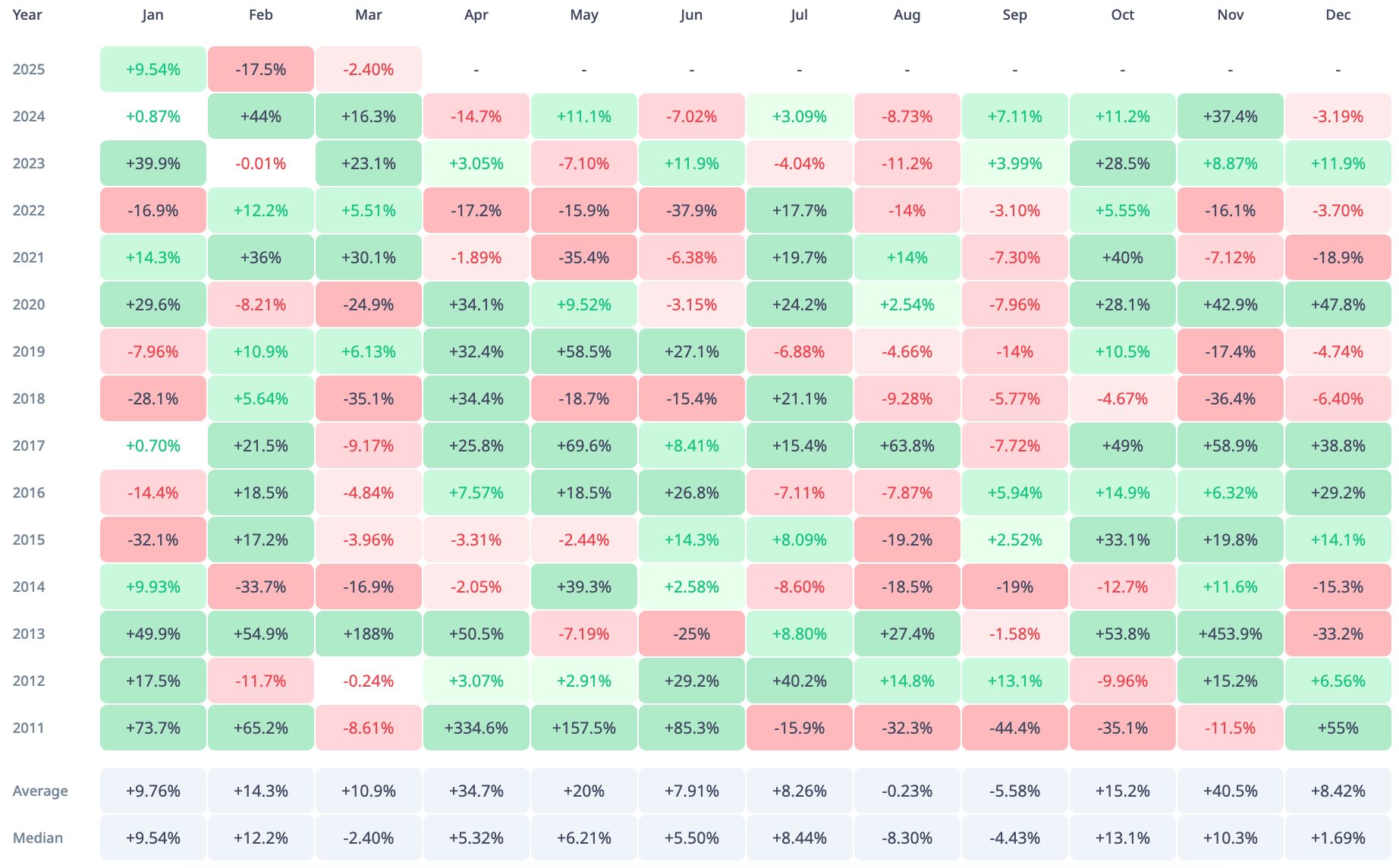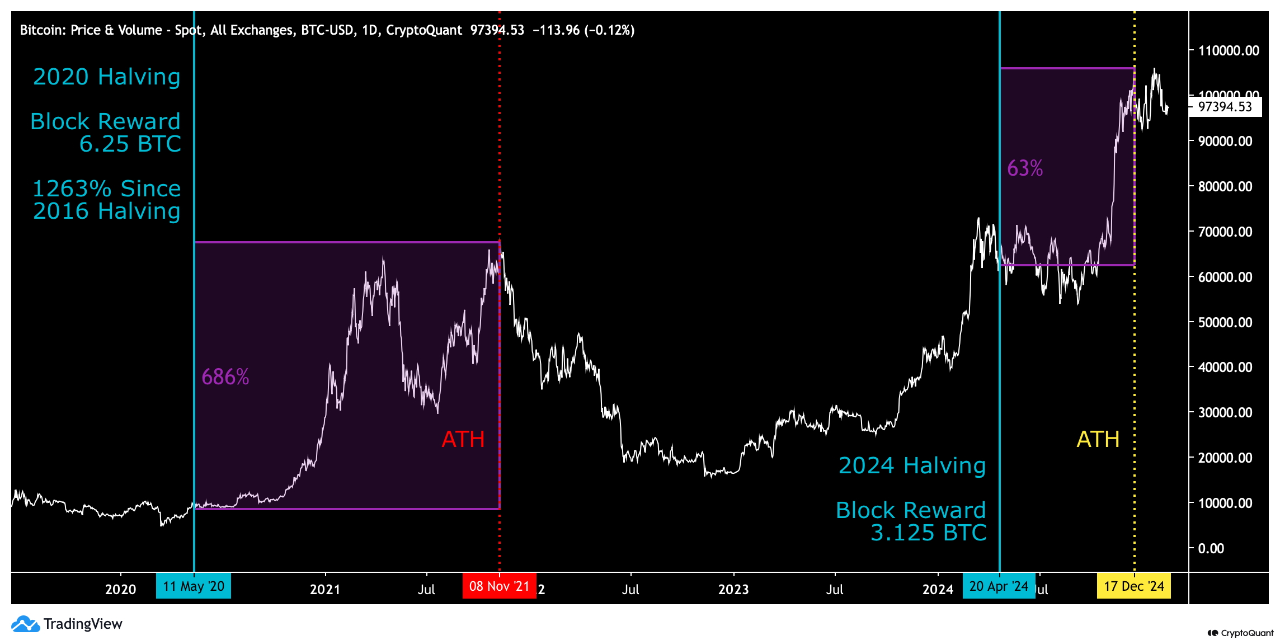Historical data indicates that Bitcoin’s price typically increases by an average of 12.98% during April. As a result, the crypto community often views April as a particularly favorable and impressive month for Bitcoin – some humorously dubbing it “Upril.”
However, the market’s recent downturn—despite multiple bullish developments, such as a crypto-friendly stance from the new U.S. administration, the recent Bitcoin halving, and ETF approvals—has significantly undermined investor confidence. Consequently, many now question whether the market will truly rebound this April as historically expected.
April Will be a Point for a New Cycle
Looking deeper into historical data, Bitcoin’s average return in April reaches as high as 34.7%, ranking second only behind November. This evidence suggests that if an investor purchases Bitcoin in late March or early April, they stand a relatively strong chance of achieving notable returns.
Moreover, according to data from CryptoRank, the median return for Bitcoin in April is approximately 5.32%, highlighting a high probability of positive market performance during this period.

Although using historical data to predict future market movements is not entirely accurate, cyclical patterns remain important indicators for the crypto community and broader markets.
“Seasonality factors typically aren’t reliable as standalone indicators. However, historical data gains greater credibility when combined with other market signals,” noted Omkar Godbole, an analyst at CoinDesk.
In his annual letter to investors, BlackRock CEO Larry Fink highlighted the mounting debt burden faced by the United States, emphasizing that interest payments alone now exceed 952 billion USD.
According to Fink, the U.S. may need to raise tariffs or corporate taxes to protect the dollar’s strength. However, such measures may hurt confidence in the USD, pushing investors toward assets like Bitcoin.
⚡️BlackRock’s Larry Fink: U.S. Dollar risks losing global reserve status to Bitcoin if U.S. doesn’t get debt under control. pic.twitter.com/KvWGCZ61ZS
— Bitcoin Archive (@BTC_Archive) March 31, 2025
Larry Fink recently disclosed that a major investment fund is actively considering allocating between 2% and 5% of its portfolio to Bitcoin. Simultaneously, BlackRock’s Bitcoin ETF has witnessed an impressive 50 billion USD inflow within just 15 months since its launch in January 2024, underscoring robust demand from traditional financial institutions.
Additionally, Bitcoin halving data shows strong post-halving growth – including a 686% surge after the third halving. However, despite the recent halving, Bitcoin has only risen 63% – modest compared to the previous cycle. Therefore, several analytics firms and organizations, including CryptoQuant and Strategy, suggest that BTC still has significant room for growth soon.
“Your lie in April”
Contrary to Larry Fink’s optimistic forecasts, several experts have urged caution. They suggest the market outlook for April 2025 may not be as positive as expected.
According to Omkar Godbole, Bitcoin still maintains a bullish long-term outlook. However, short-term risks from the Mt.Gox situation continue to weigh on the market. Recently, Mt.Gox moved a large amount of Bitcoin to Kraken, raising fears of liquidations and near-term selling pressure from creditors.
Read more: Polymarket: Most Users Bet on Bitcoin decline to $75K by April
The fallout from the Mt.Gox case may escalate further if it negatively impacts retail investor sentiment. Arthur Hayes, the former CEO of BitMEX, recently stated that Bitcoin’s price could potentially decline sharply to around 70,000 USD if ETF outflows hit the critical threshold of 30 billion USD— a clear indicator of widespread fear among retail and traditional investors.
Analysts from Glassnode echoed Hayes’s concerns, emphasizing that significant ETF outflows could indeed push Bitcoin back toward 70,000 USD.
Negative sentiment is increasingly noticeable among market participants, with some investors pointing out the seasonal pattern often referred to as “Sell in May.” Even if Bitcoin experiences substantial gains in April, caution remains warranted.
The 2021 market cycle offers a historical precedent: After reaching its peak in April, Bitcoin’s price dramatically declined in May. Analyst Oinonen from CryptoQuant similarly cautioned that early summer 2025 might see subdued market activity or an extended correction period as investors capitalize on gains from preceding months.

Additionally, bearish analysts highlight ongoing geopolitical tensions and global economic uncertainties as significant threats. For example, fears of an escalating trade war between the U.S. and its international partners intensified toward the end of Q1 following proposals by Washington’s new administration to impose higher tariffs.
These developments triggered a sharp “risk-off” sentiment. Over $160 billion in crypto market cap was wiped out in just a few days at the end of March.
If geopolitical tensions persist into April, Bitcoin’s recovery may stall as investors move away from risky assets.
Conclusion
The Q2 2025 market outlook remains complex. By Q1’s end, crypto corrected sharply – Bitcoin dropped nearly 15%, marking its worst first quarter since 2018.
The downturn was mainly driven by macro shocks, including inflation concerns and panic selling triggered by proposed U.S. tariff hikes. However, entering early April, some optimistic signs have started to emerge. Markets are slowly “digesting” tariff fears. Bitcoin has shown resilience, holding above the $85,000–$87,000 range despite ongoing volatility.
This resilience, along with hopes for a Fed policy shift, is helping restore investor confidence. Some believe Q2 2025 could resemble Q2 2019, when Bitcoin rebounded steadily from lows, fueled by new capital inflows.
Still, volatility remains high. Sudden economic or political events could shift sentiment. Most investors now feel “cautiously optimistic” — confident in the long-term, but wary of short-term risks.
Read more: Massive Token Unlocks This Week on April.
Read the full article here

